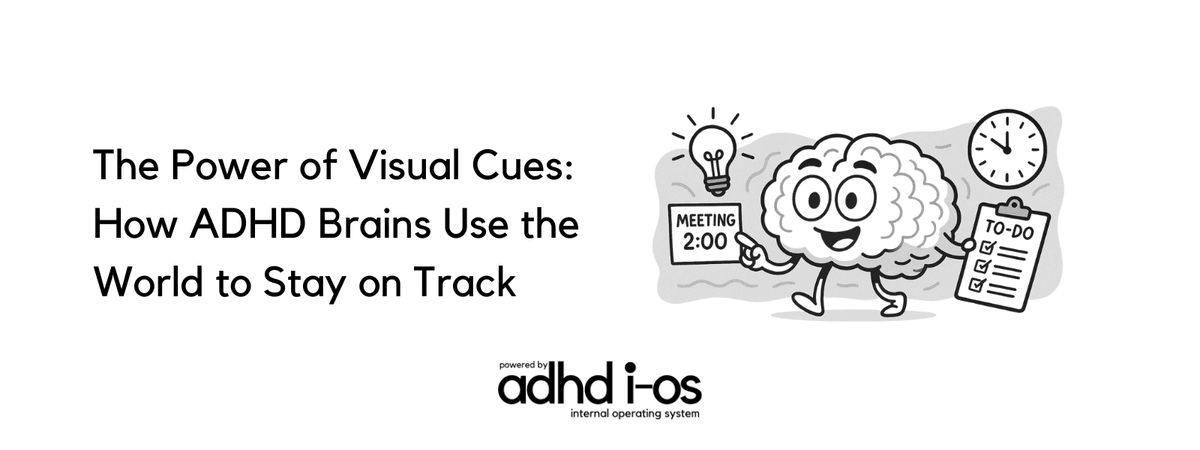The Power of Visual Cues: How ADHD Brains Use the World to Stay on Track
The Power of Visual Cues: How ADHD Brains Use the World to Stay on Track
The Power of Visual Cues: How ADHD Brains Use the World to Stay on Track
Ever walked out the door, only to realize you left your meds behind… again? Or maybe a bright sticky note saved your morning by reminding you to grab your laptop charger before a meeting?
For ADHD brains, visual cues aren’t just helpful; they’re essential. These little nudges from our environment act like external memory systems, supporting us when our brains get noisy, scattered, or overrun.
Visual cues don’t mean you’re forgetful or disorganized. They mean you’re smart enough to work with your brain, not against it.

What Are Visual Cues (and Why Do They Matter)?
Visual cues are visible prompts that catch your attention and signal a behavior, reminder, or decision. Think:
- A to-do list in bold Sharpie on your fridge
- Color-coded sticky notes on your desk
- Your keys on the doorknob, not lost in a bag
- Labels on drawers or bins so your brain doesn’t have to guess
For ADHD brains (which often struggle with working memory, task initiation, and object permanence), these external cues become cognitive tools.
Managing ADHD is about relying on the environment to carry some of the mental load.
Why ADHD Brains Need External Support
The prefrontal cortex, aka your executive functioning HQ, is the part of the brain that manages planning, remembering, and doing. In ADHD brains, this area often works less efficiently, especially under stress or distraction.
That’s where visual cues come in: they act as a bridge between intention and action. Visual cues reduce cognitive load and give your brain fewer hoops to jump through to start something.
Real-Life Visual Cues That Actually Help
When it comes to ADHD, the best visual cues are the ones that meet your brain where it is; simple, visible, and hard to ignore.
Here are a few examples of cues that can make daily life smoother and focus easier to sustain:
Cue Type - Color-coded calendars
What It Helps - Planning & transitions
Cue Type - Sticky notes
What It Helps - Micro-reminders
Cue Type - Visible tools
What It Helps - Task initiation
Cue Type - “Out in the open” items
What It Helps - Object permanence
Cue Type - Labels/signs
What It Helps - Decision-making & routine
From planning your day to actually making your way through it, these cues support how ADHD brains navigate space, time, and action.
Why It Works: The Brain Science Behind Visual Cues
ADHD brains have lower levels of dopamine and norepinephrine, which makes it harder to prioritize, initiate, and follow through on tasks.
When you use external visuals, you’re:
• stimulating the brain’s attention systems
• lowering the demand on internal memory
• turning your environment into a kind of second brain
Since you habits become something you can see, your brain finds it easier to connect intention to action.
Visual cues are also environmental “triggers” that make habits more consistent and easier to repeat, especially for neurodivergent thinkers who thrive on clear, visible prompts.
How to Build a Visual Cue System That Works
Here are some brain-friendly strategies to try in your space:
Tip - Keep it simple
Why It Helps - Too many cues = visual clutter = overwhelm
Tip - Make it visible
Why It Helps - Eye-level, high-contrast, near the action zone
Tip - Rotate cues
Why It Helps - Change colors or placement to avoid cue fatigue
Tip - Combine with timing
Why It Helps - Add Pomodoro-style timers for rhythm and pacing
Tip - Create a routine stack
Why It Helps - Daily sticky notes + checklist + visible supplies
Think of your visual system as a toolkit. The goal is not “aesthetic” but accessibility.
Common Visual Cue Pitfalls (and Fixes)
Problem - You stop noticing the cue
Fix - Change its location or color weekly
Problem - The message is too vague
Fix - Be specific: “Email Jess by 2 PM”
Problem - You keep losing the cue
Fix - Use anchored tools (like fridge magnets)
Problem - Too many cues in your space
Fix - Limit to 1–2 per zone
Remember, ADHD brains are highly sensitive to overstimulation. A few smart cues beat a wall full of sticky notes any day.
ADHD Brains Are Under-Cued, Not Forgetful
ADHD doesn’t mean you can’t remember. It means your brain remembers differently.
Visual cues are a form of accessibility, not a sign of weakness. They’re part of a bigger mindset shift: building environments that support your attention, memory, and follow-through without shame.
Try This
Add one new visual cue today:
• a sticky note
• a checklist on the fridge
• a color-coded calendar event
Then, notice if your brain responds differently when the reminder is visible.
Want more tools like these, designed specifically for your brain?
Join the adhd i-os community for weekly neuroscience-backed strategies, community tips, and visual systems that actually work.

